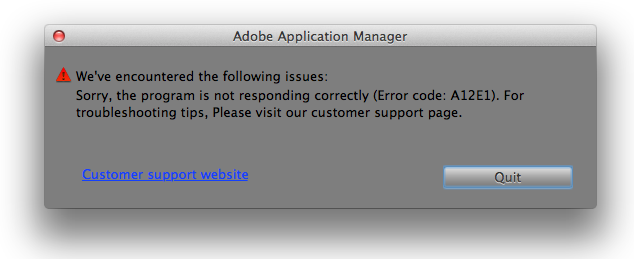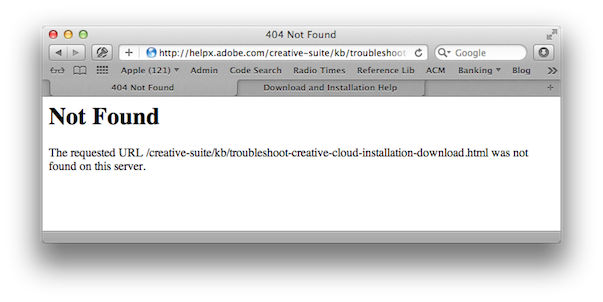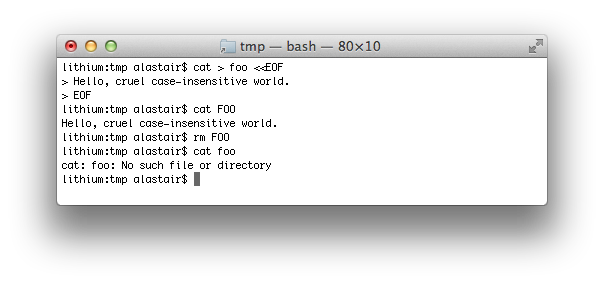If you’re a Mac or iOS developer, you’ve probably heard of UTIs; if you
come from some other platform, you probably haven’t, so I’ll start with
a quick overview.
UTI stands for Uniform Type Identifier, and it’s used in a similar way
to a MIME type—-it’s a name for a particular kind of data—-but unlike
MIME types, UTIs are based on reverse DNS syntax strings (with two
notable exceptions, which we’ll get to in a minute). If you want a new
MIME type, you either have to register it with IETF, which is
time-consuming and a source of uncertainty (they might not agree that
you need one), or you can stick an x- prefix on it (but this might
create clashes). If you want a UTI, however, all you need do is own an
Internet domain; if you own example.com, you also own all of the UTI
namespace starting com.example, so you could use com.example.MyDataType.
If you’re familiar with MIME types, you’ll also know that they’re split
into two pieces, separated by a ‘/’ character. For instance, text/plain
or image/jpeg. The part before the ‘/’ is supposed to tell you what
kind of data you’re dealing with. This is useful, but it really doesn’t
give you that much information; for instance, if you have a MIME type
starting text/, you know it’s some kind of text, but you don’t really
know how to decode it, or even if it’s compatible with US-ASCII.
UTIs, on the other hand, have a conformance hierarchy, so it’s possible
to tell the system that your wonderful new data format,
com.example.MyDataType, is actually a kind of video file. Moreover,
you can be specific about it; maybe it’s actually a special kind of
MPEG file. How does this work? Well, Apple has reserved all UTIs
starting public., and has defined a large set of standard UTIs in
that space. For instance, public.jpeg conforms to public.image,
which in turn conforms to public.data, which, in turn, conforms to
public.item. There’s actually more than one hierarchy
(e.g. public.text conforms to both public.data and
public.content), and Apple provides APIs that allow you to test any
given UTI for conformance with any other UTI.
Additionally, every UTI has associated with it a set of tags. These
are things like file extensions, MIME types and Mac OS OSType codes,
and each class of tag is identified by—-you guessed it—-a UTI. So,
the UTI for a file extension is public.filename-extension, for a
MIME type it’s public.mime-type and for an OSType it’s
com.apple.ostype. Again, APIs are provided that allow you to ask,
given a UTI, e.g. what the file extension might be for that UTI.
Finally, Apple’s platform allows applications to declare their own UTIs by
adding information to their Info.plist files, which makes them
accessible to all applications on the system.
So what, you ask? Well here’s the really clever part; there’s an API
that, given a tag class and a tag will find you the most appropriate
UTI. For instance, if you give it public.filename-extension and
jpeg, it will return public.jpeg. However, sometimes you’ll have
a file that the system doesn’t recognize; you might know something
about it (e.g. it’s file extension), but it isn’t in the system’s UTI
database, and no application has mentioned it in their Info.plist.
What happens now? Well, if, for instance, you ask for the UTI for a
file you’ve found with the extension frob, you’ll get back a rather
cryptic looking answer: dyn.age80q6xtqk.
The neat part about this odd-looking UTI is that
the information you gave the system is still there. If you ask any
Mac or iOS device for the file extension for dyn.age80q6xtqk, it
will immediately tell you: frob. You could transmit this UTI across
a network, and it would still tell you when you ask, that the
extension is frob.
This runs slightly deeper, though. When you ask for a UTI, you can
specify that it must conform to a particular type. Maybe you know
that your frob file is really some kind of public.text? In that
case, you might instead get the answer: dyn.ah62d4r34ge80q6xtqk.
You might be able to guess that this new UTI also knows that it
conforms to public.text, and again, any Mac or iOS device presented
with this UTI will be able to tell you so.
Why is this feature useful? Well, web server administrators will have
seen the unusual behaviour of various client systems when their server
doesn’t know the correct MIME type for a file; some systems try to
guess from the file extension, while others throw their hands up and
treat the file as raw data (which is probably but not necessarily the
default on any given web server). If the web used UTIs instead, the
UTI would preserve all of the information the server did have, which
would result in an improved experience in some cases.
What Apple doesn’t tell you is that these dynamic UTIs can actually
hold more than just a single tag class. For example, the UTI
dyn.ah62d4r34gq81k3p2su1zuppgsm10esvvhzxhe55c
has a MIME type (text/X-frob), and a file extension (frob) as well
as stipulating conformance to public.text. There’s no API on Mac OS
X or iOS that will construct this UTI for you, mind… so how did I do
it?
Well, the first thing you need to know is that all dynamic UTIs
currently start with the string dyn.a. The first part, dyn.
identifies the fact that it’s a dynamically generated UTI; the ‘a’ is,
I’m guessing, a format identifier (so if you’re parsing these UTIs
yourself, you must check that it’s an ‘a’ and not any other
character; if it isn’t an ‘a’, you should indicate that you don’t
understand the UTI).
Strip that off, and we have a funny looking string, which, it turns
out, is encoded in a custom form of base-32 encoding using the
encoding vector
abcdefghkmnpqrstuvwxyz0123456789
Let’s decode the dynamic UTI above and see what it contains; feeding
the string
h62d4r34gq81k3p2su1zuppgsm10esvvhzxhe55c
through a custom base-32 decoder, we get
?0=7:3=text/X-frob:1=frob
Hmmm. Let’s look at another example; say we have a custom tag class
com.example.SpecialType… let’s generate a UTI with that. Here it
is:
dyn.ah62d4r34qr104pxftbu046dqqy1fg6dfqry0c5cytf2gntpgr710e2pw
Yikes! That’s a lot longer. What happened? Well, decoding it, we
see
?0=7:com.example.SpecialType=foobar
Aha. So these are key-value pairs with the tag class and tag
respectively. What about that funny ?0=7 on the front? Well, when I
created this UTI I said it conformed to public.text. What if it
conforms instead to com.example.Borked? Now I get
dyn.ah62d425try1gn8dbrz2g23mskm11e45fqu7gg55rf3w1u2prsb0gnpwxsbw0g4pbrvnhw6dfhzxg855cqf3a
which decodes to
?0=com.example.Borked:com.example.SpecialType=foobar
Hmmm. So ?0 means “the UTI we conform to”, right? So ‘7’ must mean
public.text…
Well, it turns out that the system has a built-in list of UTIs that
get abbreviated to the hexadecimal digits ‘0’ through ‘F’. They are:
0: UTTypeConformsTo
1: public.filename-extension
2: com.apple.ostype
3: public.mime-type
4: com.apple.nspboard-type
5: public.url-scheme
6: public.data
7: public.text
8: public.plain-text
9: public.utf16-plain-text
A: com.apple.traditional-mac-plain-text
B: public.image
C: public.video
D: public.audio
E: public.directory
F: public.folder
Now we can understand the string we saw earlier;
?0=7:3=text/X-frob:1=frob
expands to
?UTTypeConformsTo=public.text:public.mime-type=text/X-frob:public.filename-extension=frob
There are, as ever, a couple of niggles. The first is that tags might
in general contain special characters (for instance, ‘=’ signs) that
would mess us up. What does the UTI system do about these? It
escapes them, that’s what. The set of characters that are escaped is:
, : = \ NUL
The ‘,’ is interesting; it turns out that each of the keys in the
string can have more than one value associated with them. That is,
it’s legal for the UTI to encode something like
?0=7,B:3=text/X-frob,image/X-frob:1=frob
resulting in something like
dyn.ah62d4r3qkk7dgtpyqz6hkp42fzxhe55cfvy042phqy1zuppgsm10esvvhzxhe55c
If you ask the system about this UTI, you’ll find that it conforms to
both public.text and public.image, in spite of the fact that
neither type conforms to the other. Unfortunately, Apple only
provides a way to copy the preferred tag given a tag class and a
UTI, so if you ask for its MIME type, you’ll only get text/X-frob
(the first one, as per the documentation).
So, in summary:
We’ve seen that UTIs can encapsulate any kind of type
information, not just the obvious ones like file extensions. You
can define your own type information, entirely orthogonal to the
set Apple uses, if you like.
We’ve seen that conformance information allows programs using UTIs
to determine that (for instance) they know how to handle data with a UTI
they’ve never even seen before because it conforms to a UTI they
do understand.
We’ve seen that it’s possible to generate dynamic UTIs that will
remember the information with which they were created even when
passed to another system.
We’ve seen how these dynamic are generated, and the mechanism by
which they hold the information given when they were created.
If you’re interested in reading Apple’s documentation, you might find
their Uniform Type Identifiers Overview
informative. Note that the format of the dynamic UTIs is
undocumented. If you are going to rely on the information I
presented above, make sure you check that they start dyn.a and
do not assume that you understand any dynamic UTI that has a
different format identifier.




